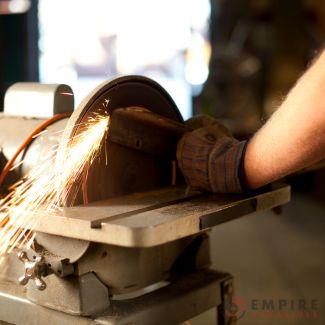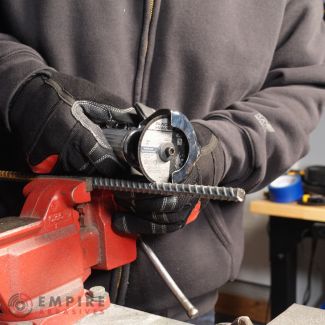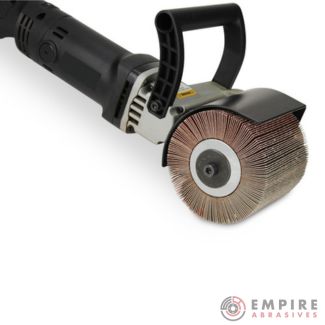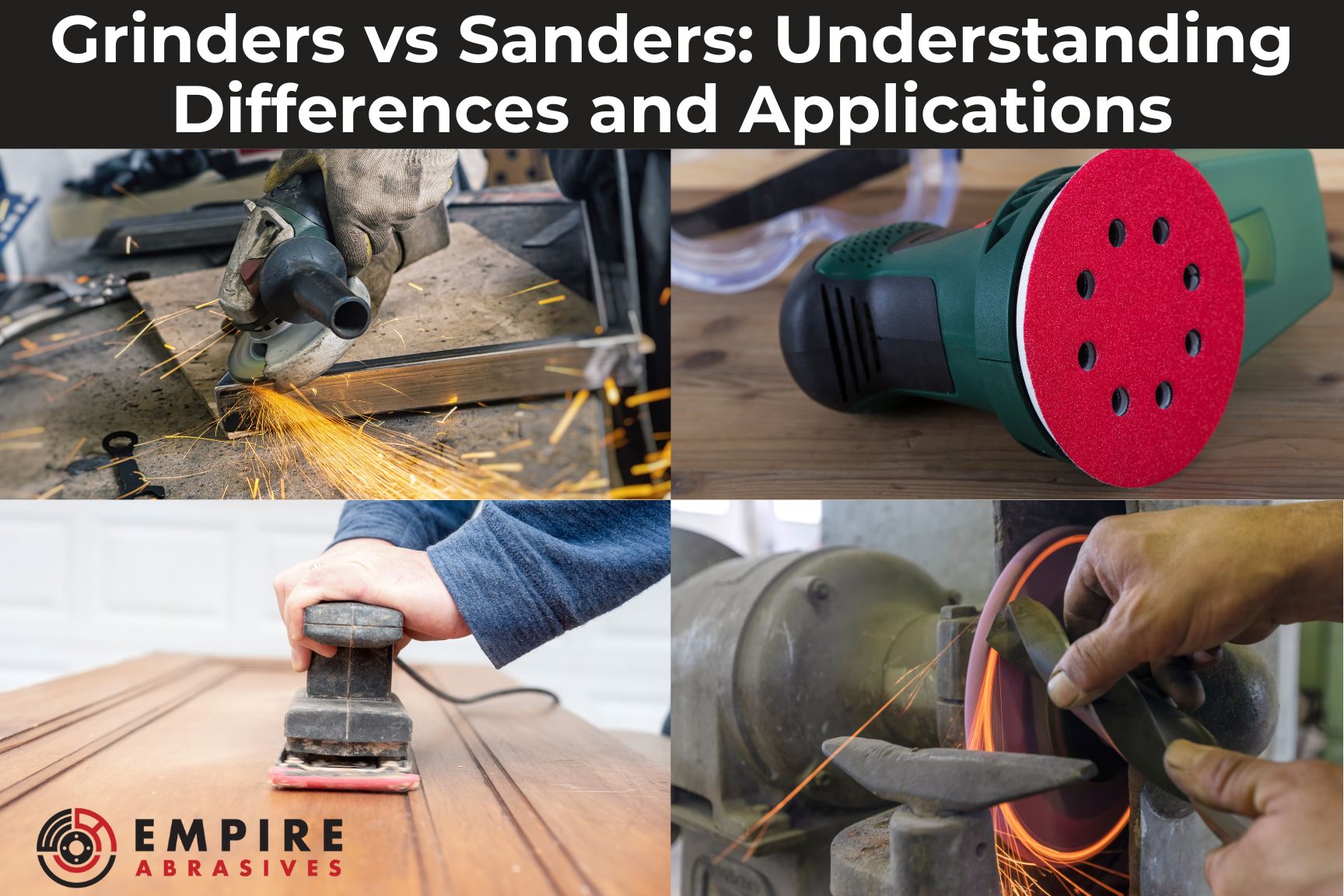
Are you facing a project that requires some material removal? You might be wondering: should you reach for a sander or a grinder?
When it comes to woodworking, metalworking, or any DIY project involving surface preparation and finishing, there are two main types of tools you can use, a sander or a grinder. While both are often similar looking tools that whir and spin, each serves specific uses in the workshop.
In this guide, we'll get into the differences between grinders and sanders and what each is best suited for, helping you understand which tool is best for your sanding or grinding needs.
Sanders vs Grinders: Key Differences Explained
Sanders are highly specialized and proficient in precision tasks, but they lack adaptability. On the other hand, Grinders are remarkably adaptable tools. With swappable discs, they can perform diverse functions, such as cutting, grinding, sharpening, polishing, and rust removal.
What is a Sander?
Sanders are designed for smoothing surfaces through abrasion, gently removing material from a surface. They do this by moving sanding discs, sandpaper sheets, or a sanding belt across the material's surface in either a circular or linear motion.
*Gently when compared to an angle grinder. They remove much less material, but still pack some power and can damage a surface if not used correctly.
There are several types of sanders, including orbital sanders, belt sanders, longboard sanders, and disc sanders. Each of these power sanding tools offer different patterns and finishes for fine surface preparation or finishing work.
What is a Grinder?
Picture sparks flying or cutting through metal with ease. Grinders are powerful tools used that operate at high speeds for much more aggressive material removal. They use a hard, abrasive disc or wheel to cut, grind, or polish surfaces.
There are different types of grinders available, such as angle grinders, bench grinders, or die grinders. They are the go-to tools for heavy-duty tasks like cutting metal, grinding welds, and sharpening tools.
Applications and Uses
Sanders: For the Fine Finish
Imagine a perfectly smooth, polished surface. This is what you can achieve with a sander and a little work. Sanders are mostly used on wood and drywall but can also be effective on metals, plastics, and composites with the right abrasive product. They're ideal for tasks like removing old paint or varnish, smoothing out surfaces, and preparing them for a new coat of paint or varnish.
Common Uses for Sanders:
- Smoothing and leveling surfaces of wood, metal, and other materials
- Removing old paint, varnish, and other coatings
- Preparing wood surfaces for painting, staining, or other finishes
- Creating smooth, curved shapes and contours
- Sanding down rough edges and corners
- Polishing and buffing surfaces
Grinders: The Heavy-Duty Challenger
Grinders excel in cutting through metal, shaping stone, or smoothing welds. They are more versatile, able to be used on various materials, including metal, stone, and concrete. This makes them indispensable for projects requiring significant material removal or shaping.
Common Uses for Grinders:
- Cutting and shaping metal, concrete, and other materials
- Removing rust, scale, and other buildup from surfaces
- Grinding down welds and rough edges
- Sharpening tools and blades
- Polishing and buffing metal surfaces
- Deburring and chamfering edges
Finish and Precision
While grinders are known for their aggressive removal capabilities, they can leave behind a rough finish. Sanders, with their gentler approach, are preferred for achieving a smooth, ready-to-finish surface. It's not uncommon to start a project with a grinder for the heavy lifting and switch to a sander for the final touch-ups.
Abrasive Products for Sanders and Grinders
Abrasive products are essential for sanding and grinding applications, providing the cutting action needed to shape and smooth materials. They come in various forms, including sanding belts, discs, sheets, and grinding wheels, each designed for specific purposes.
Here are some common types of abrasive products used with sanders and grinders:
Common Abrasive Products for Sanders:

- Sanding Discs: These are circular abrasive discs that are attached to a backing pad on a disc sander. They are coated abrasives that come in various diameters and grits and are often used for sanding flat surfaces and contours. The most used types are resin fiber discs, PSA sanding discs, and hook and loop sanding discs.
- Sanding Sheets: These are rectangular sheets of abrasive material that are attached to a sanding block or a hand sander. They are commonly used for hand sanding and provide precise control for detailed work.
- Polishing Discs: These are specialized abrasive discs designed for polishing and finishing surfaces. They are typically made of fine abrasives and are used to achieve a smooth, glossy finish on various materials.
- Longboard Sandpaper: These are long, narrow sanding strips specifically designed to attach to tools like longboard sanders, straight line air sanders, file boards. They are commonly used for autobody work, furniture making, and in the marine industry for boat building and maintenance.
- Sanding Belts: These are continuous loops of abrasive material that are wrapped around a drum or attached to a belt sander. They are available in different grits and materials, suitable for a wide range of sanding tasks on wood, metal, and other surfaces.
Common Abrasive Products for Grinders:

- Grinding Wheels: These are abrasive wheels that are mounted on a grinder and used for heavy-duty grinding and cutting applications. They come in different shapes, sizes, and grit levels, suitable for working on metal, concrete, and other hard materials.
- Cut-Off Wheels: These are thin, reinforced abrasive wheels designed for cutting through metal, plastic, and other materials. They are commonly used in angle grinders and provide fast, precise cuts.
- Wire Wheels and Brushes: Abrasive tools made of crimped or knotted wire bristles. Effective for surface prep, cleaning, removing rust, paint, and coatings from metal surfaces. Wire wheels cover larger areas, while cup brushes and end brushes can target specific areas.
- Flap Discs: These are abrasive discs composed of multiple overlapping flaps of sandpaper sheets. They are extremely versatile and ideal for grinding and finishing curved surfaces and provide a consistent finish.
- Sanding Belts: This was mentioned in the sanders section earlier, but with different abrasive material, like a ceramic sanding belt on a stationary belt sander, these can function as a grinder to remove material fast from most surface types.
Other Types of Sanders and Grinders
Generally, when someone mentions a sander or a grinder, they mean something like the orbitals, belts, and angle grinders mentioned above. However, there are several lesser-known tools that offer specialized functions. Below are a few of these specialty sanders and grinders.
Detail Sanders (also known as mouse sanders)
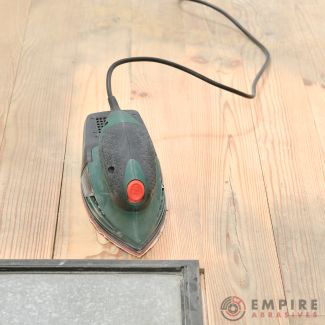
- Designed for precision work and getting into tight spaces
- Small, triangular-shaped pads
- Perfect for sanding corners, intricate details, and areas that larger sanders cannot reach
- Ideal for furniture refinishing or detailed woodworking projects
- Help to achieve a fine finish in nooks and crannies
- Particularly useful for flush cuts, plunge cuts, and sanding tasks in tight spaces
Bench Sanders
- Stationary sanding solution with stability and power.
- Often combined as a belt sander and disc sander in one.
- Versatile for flat surfaces, edges, and curves.
- Perfect for resizing, shaping, or smoothing wood and metal.
Die Grinders
- Handheld power tools for grinding, sanding, and machining.
- Similar to rotary tools, but larger and more powerful.
- Ideal for heavy-duty tasks with various attachments.
- Precision and versatility in material removal and surface prep.
Concrete Grinders
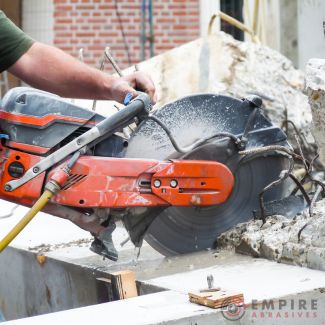
- Heavy-duty grinders for leveling, coating removal, and more.
- Diamond tooling or abrasive discs tackle various tasks.
- Essential for construction, floor installation, and concrete repair.
Drum Sanders
- Powerful tools for heavy-duty sanding, especially in woodworking.
- Rotating 3.5”-4.5” sanding drum with sand band or other abrasive (flap wheel, buffing, etc.) for large surface smoothing.
- Quickly and efficiently remove material for leveling and smoothing.
- Other names include linear grinders, surface conditioning tools, and popular brand names like Eastwood® Contour SCT.
Sander vs Grinder - Making the Right Choice

Choosing between a grinder and a sander comes down to understanding your project's requirements. If you're dealing with heavy material removal or need to shape materials, a grinder is your best bet. For finishing touches and surface smoothing, a sander will serve you better.
Below are a few different project scenarios, with recommendations on whether a sander or grinder is more suitable, including a brief explanation and a product recommendation from Empire Abrasives.
1. Removing Rust from Metal Surfaces
- Recommended Tool: Grinder
- Recommended Product: Angle Grinder with a wire cup brush or a strip disc
- Why: Grinders, with their powerful motor and abrasive capabilities, are ideal for quickly removing rust and corrosion from metal surfaces, preparing them for painting or welding. Wire cup brushes and strip discs are great for removing rust, without damaging the underlying material. Though, if you can spare to remove some surface material, you can also use a flap disc, grinding disc,
2. Refinishing a Wooden Deck
- Recommended Tool: Sander
- Recommended Product: Orbital Sander with medium to coarse grit gold sanding disc
- Why: For smoothing out rough wood and removing old paint or stain from decks, an orbital sander is gentle yet effective, ensuring an even and smooth finish that's ready for resealing.
3. Sharpening Tools
- Recommended Tool: Bench grinder or belt sander
- Recommended Product: PSA Disc or Sanding Belt
- Why: A bench grinder is perfect for sharpening most tools like chisels, axes, and lawn mower blades, offering precision and the ability to handle hard materials.
4. Preparing Drywall for Painting
- Recommended Tool: Sander
- Recommended Product: Drywall Sander with fine grit aluminum oxide sandpaper
- Why: Sanders provide a smooth finish on drywall, removing imperfections and creating a surface that's ideal for painting.
5. Cutting Metal Pipes
- Recommended Tool: Grinder
- Recommended Product: Angle Grinder with a cut-off wheel
- Why: Grinders are powerful enough to cut through metal pipes quickly and efficiently, making them essential for plumbing projects or metal fabrication.
6. Refurbishing Furniture
- Recommended Tool: Sander
- Recommended Product: Detail Sander with fine grit sandpaper
- Why: A detail sander can navigate the tight corners and intricate details of furniture, removing old finish or sanding down surfaces for a new coat of paint or stain.
7. Smoothing Welded Joints
- Recommended Tool: Grinder
- Recommended Product: Angle Grinder with a grinding disc
- Why: For smoothing out welded joints and ensuring a clean, flat finish on metal workpieces, an angle grinder is the tool of choice.
8. Finishing Countertops
- Recommended Tool: Sander
- Recommended Product: Random Orbital Sander with fine grit sandpaper
- Why: When finishing wooden, laminate, or even some composite countertops, a random orbital sander can achieve a smooth, flawless finish without leaving swirl marks.
Obviously, we can’t go on with every scenario that would use a grinder or a sander, so if you still have questions, our abrasives experts are a phone call or email away.
Safety First, Always:
Remember, power comes with responsibility. Both sanders and grinders can be dangerous if used improperly. Eye protection, gloves, and dust masks are your essential armor. Dust, flying debris, and sharp edges are no joke, so suit up before you power up.
So, Grinder vs Sander: The Verdict?
Now, the shorter answer for which tool is right for you?
- Material matters: Grinders can take on tough materials like metal, stone, and concrete. Sanders will be better choices on softer surfaces like wood, plastic, and drywall.
- Versatility counts: Grinders offer more flexibility with interchangeable discs for cutting, grinding, polishing, and more. Sanders should be used more for smoothing and finishing.
- Precision is key: For fine sanding or detailed shaping, a sander is your friend. Grinders are better for rougher tasks where precision isn't as important.
At Empire Abrasives, we understand the importance of having the right tools and accessories for your projects. Browse our extensive selection of quality abrasives and tools to find the perfect match for your next project. If you stll have questions or need some advice, our abrasives experts are here to help.

